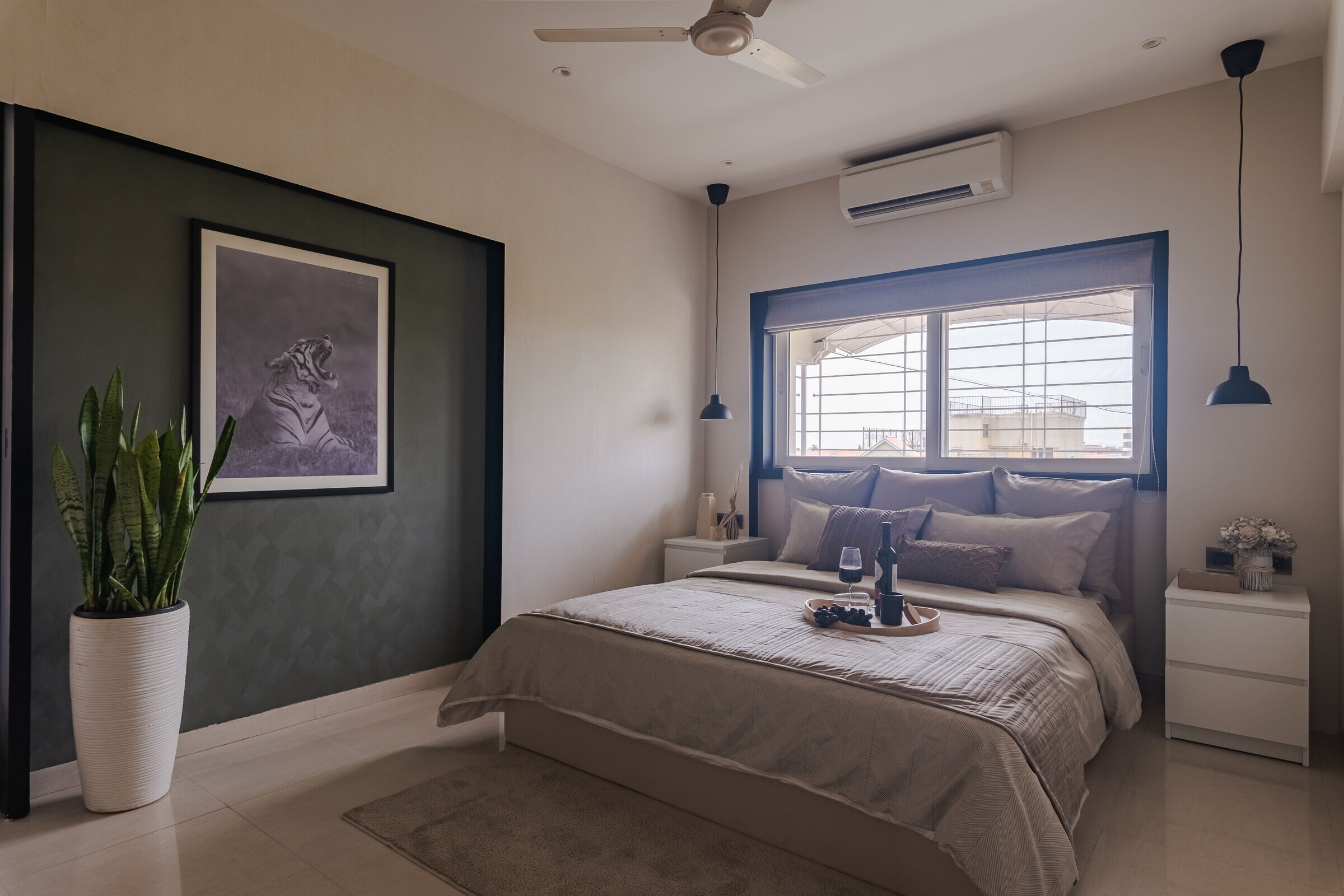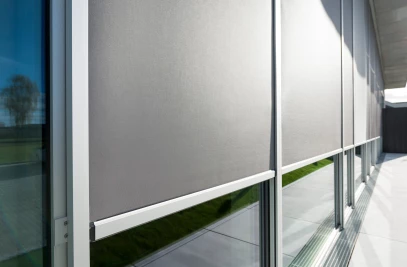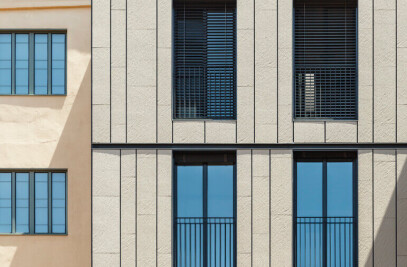1. Please take us through the project for someone to explore it on foot, like a virtual walk-through. Let's begin our home tour from the entrance! A textured wall, adorned with raw wood and a towering planter, welcomes you with a warm embrace. The earthy tones and luxurious textures set the stage for a home that promises comfort and sophistication. As we move into the heart of the home, the living area unfolds before us. Clean lines and geometric shapes dominate the space. A plush sofa, upholstered in boucle fabric, invites you to relax, while the elliptical center table, adorned with natural elements, adds a touch of organic charm. The glass partition offers a seamless transition to the lounge area, creating a sense of openness and flow. A splash of sunlight streams through the west-facing windows, illuminating a cozy corner. This intimate space, perfect for quiet reflection, is a testament to the home's ability to offer communal and private retreats.
Continuing our trail, we enter the dining area. A rustic, in-situ wooden bench paired with a metal-coated table creates a unique and inviting atmosphere. The interplay of natural materials and modern elements is a true hallmark of the home's design philosophy.
The bedroom is a sanctuary of calm. Neutral tones and soft textures envelop you, creating a space conducive to rest and rejuvenation. The wardrobe doors, with their concealed handles, maintain the clean lines of the design. A subtle pop of olive green adds a touch of vibrancy to the space. And finally, we ascend to the terrace, a hidden gem. The partially covered space, adorned with solar panels, offers a versatile outdoor retreat. Lush greenery, a barbecue area, and quiet corners for relaxation create a perfect balance of functionality and aesthetics.
This Mumbai apartment is a home where every corner tells a story of thoughtful curation and a deep understanding of the client's needs. It's a space where tradition and modernity coexist in harmony, creating a unique and inspiring living environment.
2. What was the client’s brief and how did that influence the overall concept you had in mind for the project?
The client sought a transformative redesign of their rented Mumbai apartment. They desired a space that transcended the limitations of a traditional dwelling, offering warmth, solace, and a sense of familiarity while incorporating fresh design elements. The brief emphasized the importance of optimizing storage, enhancing functionality, and creating a visually appealing yet practical living environment.
Influenced by the client's desire for a harmonious blend of tradition and modernity, the design concept revolved around the idea of a "design metamorphosis." The focus was on maximizing the potential of the existing space through intelligent storage solutions while infusing it with a contemporary aesthetic. The use of natural materials, earthy tones, and a mix of textures created a warm and inviting atmosphere. By carefully selecting and integrating new elements, we aimed to preserve the apartment's familiar character while elevating its overall appeal. The design sought to showcase the transformative power of design, demonstrating how even a rented space can be transformed into a personalized and inspiring home.

3. Did you follow a particular theme for the project?
The design intentionally prioritized simplicity and functionality while incorporating natural elements and textures to create a warm and inviting atmosphere. The use of earthy tones, raw materials like wood and stone, and the emphasis on open spaces are all indicative of this theme. While there's a clear focus on minimalism, the organic elements prevent the space from feeling cold or sterile. Instead, it fosters a sense of connection to nature and tranquility. This approach is evident in the choice of materials, colour palette, and even the layout of the spaces.
4. Explain in detail various elements that were used in this project. (Concerning material, wood, paint, wallpaper, flooring, ceiling, etc.)
The project leaned heavily on a palette of natural and earthy tones. Raw wood was a prominent feature, utilized in the textured wall, the elliptical center table, the dining bench, and chair frames. Boucle and jute-textured fabrics were employed for upholstery, adding warmth and tactile interest. A splash of olive green in the bedroom provided a vibrant counterpoint to the overall neutral scheme. The terrace showcased the integration of solar panels, a practical and sustainable choice. Minimal use of wallpaper was evident, with a focus on creating impact through texture and materiality. Flooring likely consisted of a combination of tiles and wooden elements, while the ceiling was left unadorned to maintain a sense of openness.
5. Tell us about the colour palette? Why have you chosen it and how have you balanced it?
The colour palette for this Mumbai apartment is an artful blend of earthy tones and luxurious textures, curated to evoke a sense of warmth, solace, and familiarity. The foundation is laid with a neutral base, allowing for the infusion of deeper, richer hues without overwhelming the space. Muted shades of beige, taupe, and grey create a serene backdrop that complements the natural light filtering through the apartment.
To add depth and character, earthy tones like olive green and terracotta are introduced in subtle accents. These colours bring a touch of nature indoors, fostering a connection with the outside world. Luxurious textures, such as boucle fabric and jute, add warmth and tactile interest, while the interplay of raw wood and stone elements grounds the space and creates a sense of authenticity.
The colour palette is intentionally balanced to avoid overwhelming the senses while still creating a visually engaging environment. This careful balance ensures that the space remains inviting and relaxing, a true sanctuary within the bustling city. By prioritizing a restrained and harmonious colour palette, we achieved a timeless aesthetic that allows the architectural features and natural light to shine.
6. Tell us about the sustainability features (if any).
While the primary focus of the apartment design was on aesthetics and functionality, there are some notable sustainability features incorporated into the project. The most prominent sustainable element is the terrace. Adorned with solar panels, it harnesses the abundant sunlight in Mumbai to generate renewable energy. This helped reduce the carbon footprint of the apartment and serve as a practical demonstration of sustainable living.
Additionally, the emphasis on natural light and ventilation throughout the apartment minimizes the reliance on artificial lighting and air conditioning, contributing to energy efficiency. The use of natural materials like wood and stone, while not explicitly mentioned as sustainably sourced, aligns with a general trend towards eco-friendly choices in interior design.
However, it's important to note that the text doesn't delve into specific details about the sustainability of materials, construction methods, or waste management practices. A truly sustainable project would likely involve a more comprehensive approach, including these aspects.
7. Which part of the space did you enjoy designing the most and why?
The terrace was undoubtedly the most rewarding space to design. Transforming an underutilized outdoor area into a versatile haven of tranquility, leisure, and sustainability was an incredibly fulfilling challenge! The opportunity to balance functionality with aesthetics, and to create a space that beautifully integrated with the interior of the apartment offered a distinct outdoor experience, was truly inspiring.
Furthermore, the integration of solar panels, coupled with the careful selection of foliage and designated zones for various activities, allowed us to create a space that is visually appealing, environmentally conscious and highly functional more like a personal oasis amidst the hustle and bustle of citylife
8. How does your firm's design ethos relate to the project?
We at Studio SB firmly believe that designing a space is more like nurturing the soul and reflecting the unique personality of its inhabitants. The Mumbai apartment project is a reflection to the same philosophy. By focusing on transformation, rather than mere decoration, we created a space that is aesthetically pleasing and deeply resonant.
9. Any other design aspect that you would like to highlight? What is the USP of this project
A standout aspect of this project is the effortless integration of functionality within a visually appealing aesthetic. The in-situ bench crafted from logs of wood in the dining area is not merely a design element but a practical solution for space optimization. Similarly, the terrace, while a haven of tranquility, is also a resourceful space equipped with solar panels, demonstrating a commitment to sustainability. This project excels in demonstrating how design can enhance everyday living without compromising on style.
The USP of this project lies in its ability to transform a rented apartment into a personalized sanctuary. By focusing on the transformative power of design, we were able to create a space that resonates with the homeowner's needs and aspirations. All in all, the project showcases the potential of design to elevate living spaces, even within the constraints of a rental property.
10. Please elaborate on the challenges you faced while designing this project and how you overcame them.
Designing a rented apartment in Mumbai presented a unique set of challenges. While structural changes were off-limits, even alterations to the existing layout were restricted. Furthermore, the original design of the home was characterized by an abundance of storage and conventional motifs, which conflicted with the desired modern aesthetic.
To overcome these hurdles, a strategic approach was adopted. The focus shifted to maximizing the potential of the existing space through clever spatial planning and the judicious use of furniture and decor. Custom-designed storage solutions were incorporated to optimize functionality without compromising the visual appeal. The challenge of integrating modern elements into a traditional setting was addressed by carefully selecting pieces that complemented the existing architecture while introducing contemporary accents. The use of colour, texture, and lighting played a crucial role in transforming the space without making drastic alterations. By prioritizing a holistic design approach and a deep understanding of the client's needs, we transformed the apartment into a warm and inviting home.
Credits:
Name of the spokesperson: Sharmin Wade & Saumitra Bhatkhalkar Firm Name: Studio SB Design Team and Designation: Architects : Ar. Sharmin Wade, Ar. Ana Rizvi, ID Gayatri Adurkar Instagram handles to be tagged: @studio_sb_mumbai @bhatkhalkar_saumitra_ @sharmin_wade Website: https://www.studiosb.in/ Location of the project: Mumbai Area (Sq.ft): Photo courtesy: Archceptions by Nisheet Dodhia




























